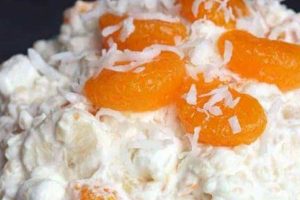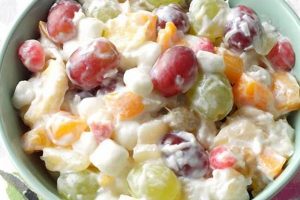A blend of fresh, seasonal fruits, often incorporating regional variations, characterizes a typical fruit salad from India. Common ingredients might include mangoes, bananas, papaya, pomegranate seeds, and apples, dressed with a squeeze of lime or a sprinkle of chaat masala for a tangy, savory twist. Some versions might feature more exotic fruits like guava or chikoo, and occasionally, a touch of honey or ginger is added for sweetness and complexity. This culinary creation provides a refreshing and nutritious snack or dessert.
Fruit salads offer significant nutritional value due to their high vitamin, mineral, and antioxidant content. They serve as a healthy and hydrating option, especially in warm climates. In India, these vibrant mixtures often play a central role in celebrations, festivals, and everyday meals, reflecting a cultural emphasis on fresh, seasonal produce. The practice of combining diverse fruits, often representing regional specialties, showcases the countrys rich agricultural diversity and culinary heritage.
The following sections will delve into various aspects of creating and enjoying these delightful combinations, including regional variations, ingredient selection, preparation techniques, and serving suggestions.
Tips for Creating a Delicious Indian Fruit Salad
Achieving a balanced and flavorful fruit salad requires careful consideration of ingredient selection, preparation techniques, and flavor combinations. The following tips offer guidance for creating a delightful and refreshing experience.
Tip 1: Embrace Seasonal Fruits: Utilizing fruits at their peak ripeness ensures optimal flavor and sweetness. Selecting produce readily available within a particular season guarantees freshness and minimizes environmental impact.
Tip 2: Balance Sweetness and Tartness: Incorporating a variety of fruits with varying levels of sweetness and acidity creates a more complex and balanced flavor profile. Combining sweet mangoes with tart green apples, for instance, offers a contrasting yet harmonious taste.
Tip 3: Consider Textural Variety: Including fruits with diverse textures adds another layer of enjoyment. The soft creaminess of bananas can complement the crispness of apples or the juicy burst of pomegranate seeds.
Tip 4: Enhance with Aromatic Spices: A sprinkle of chaat masala, a pinch of roasted cumin powder, or a touch of black salt can elevate the flavor profile, adding a characteristically Indian touch. Experimenting with these spices unlocks unique flavor dimensions.
Tip 5: Exercise Restraint with Sugar: Allow the natural sweetness of the fruits to shine. Added sugar often masks the delicate flavors of the fresh produce. A squeeze of lime or lemon juice can enhance sweetness without adding extra sugar.
Tip 6: Prepare Just Before Serving: To prevent oxidation and maintain the vibrant colors and fresh flavors of the fruits, it’s recommended to prepare the salad shortly before serving. This preserves the optimal texture and appearance of the dish.
Tip 7: Explore Regional Variations: India’s diverse regions offer unique fruit varieties and flavor combinations. Researching regional specialties can inspire creative and authentic culinary experiences.
By following these guidelines, one can craft a fruit salad that is not only refreshing and nutritious but also showcases the vibrancy and diversity of Indian flavors.
The following section will offer concluding thoughts and further inspiration for incorporating these delightful creations into various culinary occasions.
1. Fresh, Seasonal Fruits
The cornerstone of an authentic Indian fruit salad lies in the utilization of fresh, seasonal produce. This emphasis on seasonality not only guarantees optimal flavor and nutritional value but also connects the dish to the agricultural rhythms and regional diversity of India. Exploring the nuances of this connection provides a deeper understanding of the culinary tradition.
- Availability and Flavor:
Seasonal fruits offer the most intense flavors and sweetness as they have ripened naturally on the vine. Mangoes during summer, apples in the fall, and strawberries in the winter exemplify this principle. Employing in-season produce elevates the taste profile of the salad and avoids the blandness often associated with out-of-season, artificially ripened fruits. This commitment to peak ripeness is a defining characteristic of Indian cuisine.
- Nutritional Value:
Fruits harvested at their peak ripeness generally possess higher concentrations of vitamins, minerals, and antioxidants. Consuming seasonal fruits ensures maximum nutritional benefit, contributing to a healthier diet. This aligns with the Ayurvedic principles of incorporating fresh, locally sourced ingredients for optimal well-being, a philosophy often reflected in traditional Indian culinary practices.
- Regional Diversity:
India’s diverse climate and terrain yield a vast array of fruits unique to specific regions. From the Alphonso mangoes of Maharashtra to the Langra mangoes of Uttar Pradesh, each region boasts its specialties. Utilizing these regional fruits not only adds unique flavor profiles but also celebrates the country’s agricultural biodiversity. This regional focus allows for an exploration of diverse flavors and textures, resulting in a wide array of fruit salad variations across the country.
- Cultural Significance:
The use of seasonal fruits in Indian cuisine extends beyond mere flavor and nutrition. It reflects a deep connection to the land and an appreciation for the natural cycles of growth and harvest. Many festivals and celebrations feature specific seasonal fruits, highlighting their cultural importance. This connection to nature and tradition adds depth and meaning to the seemingly simple act of preparing a fruit salad.
By prioritizing fresh, seasonal ingredients, the Indian fruit salad transcends its role as a simple dish and becomes a reflection of India’s agricultural richness, culinary wisdom, and cultural heritage. This approach ensures not only a delicious and nutritious culinary experience but also a deeper connection to the land and its bounty.
2. Regional Variations
Regional variations play a crucial role in shaping the diverse landscape of Indian fruit salads. India’s vast geographical expanse and varied climates contribute to a rich assortment of fruits unique to specific regions. This diversity influences the choice of ingredients, flavor profiles, and even the cultural significance attributed to fruit salads in different parts of the country. Understanding these regional nuances provides a deeper appreciation for the complexity and adaptability of this seemingly simple dish.
For instance, in the coastal regions of Maharashtra, one might find fruit salads featuring Alphonso mangoes, kokum, and sometimes even a touch of coconut. The inclusion of kokum, a tart fruit local to the Western Ghats, adds a distinctive tanginess characteristic of the region’s cuisine. In contrast, the northern states of Uttar Pradesh and Bihar often showcase Langra mangoes, known for their aromatic sweetness, alongside guava and sometimes even seasonal berries. The availability of specific fruits dictates the composition of the salad, creating distinct regional identities. Further south, in Kerala, one might encounter fruit salads incorporating bananas, pineapples, and jackfruit, reflecting the tropical abundance of the region. These examples illustrate how regional variations dictate not only the choice of fruits but also the overall flavor profile of the salad, showcasing the adaptability of the concept across diverse culinary landscapes.
This regional diversity extends beyond mere ingredient selection. Preparation methods and serving styles also vary across different parts of India. Some regions might prefer a simple squeeze of lime or a sprinkle of chaat masala, while others might incorporate yogurt or honey for added richness and flavor. The cultural context surrounding fruit salads also varies. In some regions, they are a staple part of everyday meals, while in others, they are reserved for special occasions and festivals. Recognizing these regional variations provides a deeper understanding of the complex interplay between geography, agriculture, and culinary traditions in shaping the character of Indian fruit salads. This appreciation enhances the culinary experience and allows for a more nuanced understanding of the diverse culinary heritage of India.
3. Balancing Flavors
Balancing flavors is paramount in creating a harmonious and enjoyable Indian fruit salad. The interplay of sweet, tart, tangy, and sometimes even spicy elements defines the character of the dish. Achieving this balance elevates the salad from a simple mix of fruits to a complex and refreshing culinary experience. A well-balanced fruit salad stimulates the palate and offers a more satisfying sensory experience.
- Sweetness as a Foundation:
Sweetness forms the base of most fruit salads. Ripe mangoes, bananas, and grapes provide this essential sweetness. However, relying solely on overly sweet fruits can result in a monotonous flavor profile. Therefore, incorporating fruits with varying degrees of sweetness is essential. This foundational sweetness serves as a canvas upon which other flavors can be layered, creating a more nuanced and engaging taste experience.
- Tartness as a Counterpoint:
Tart fruits, such as green apples, pineapple, or oranges, provide a crucial counterpoint to the sweetness. This tartness cuts through the richness of the sweeter fruits, preventing the salad from becoming cloying. The interplay of sweet and tart creates a dynamic flavor profile that keeps the palate engaged. This balance ensures a refreshing and invigorating culinary experience, rather than an overwhelmingly sweet one.
- Tanginess as an Enhancer:
Tanginess adds another dimension to the flavor profile. A squeeze of lime or lemon juice, or the addition of a tangy fruit like pomegranate, introduces a vibrant acidity. This tanginess not only enhances the sweetness of the fruits but also adds a refreshing zest. It also helps to balance the flavors, creating a more complex and nuanced taste.
- Spice as a Complexity Factor:
While not always present, spices can play a crucial role in balancing flavors in Indian fruit salads. A sprinkle of chaat masala, a blend of spices including cumin, coriander, and chili powder, adds a savory and sometimes spicy dimension. This unexpected element complements the sweetness and tartness of the fruits, creating a unique flavor profile characteristic of Indian cuisine. The judicious use of spices adds depth and complexity, transforming a simple fruit salad into a more sophisticated culinary creation.
The careful balancing of these flavor componentssweetness, tartness, tanginess, and spicedistinguishes an Indian fruit salad. This approach demonstrates a sophisticated understanding of flavor profiles and contributes to a more satisfying and memorable culinary experience. It exemplifies the culinary principle of balancing contrasting flavors to create a harmonious whole, a characteristic often seen in Indian gastronomy.
4. Spice Combinations
Spice combinations play a distinctive role in Indian fruit salads, differentiating them from other global variations. While sweetness and tartness provide the foundational flavor profile, spices introduce complexity and depth, reflecting the characteristic boldness of Indian cuisine. The strategic use of spices elevates the fruit salad beyond a simple refreshment, transforming it into a more nuanced culinary experience. This practice highlights the integral role of spices in Indian culinary traditions, where they are used not merely for heat but to enhance and balance flavors.
Chaat masala stands out as a quintessential spice blend in Indian fruit salads. Its unique combination of tangy, salty, and slightly spicy flavors, derived from ingredients like dried mango powder (amchur), black salt (kala namak), cumin, and coriander, complements the sweetness of fruits like mangoes, bananas, and papayas. The addition of chaat masala creates a flavor profile that is both familiar and exciting, appealing to those seeking a more savory dimension in their fruit salad. Beyond chaat masala, other spice combinations, such as roasted cumin powder, black pepper, or even a pinch of red chili powder, can be employed to create unique flavor profiles tailored to individual preferences. For instance, roasted cumin powder adds an earthy warmth that pairs well with apples and pears, while black pepper provides a subtle heat that enhances the sweetness of melons. These examples illustrate the versatility of spices in complementing and enhancing the natural flavors of fruits.
Understanding the role of spice combinations in Indian fruit salads provides valuable insight into the broader principles of Indian cuisine. The emphasis on balancing flavors, incorporating diverse textures, and utilizing spices to create depth and complexity are hallmarks of Indian culinary traditions. The seemingly simple act of adding spices to a fruit salad reflects a deeper cultural appreciation for the transformative power of spices. This practice adds not only flavor but also a unique cultural dimension to the dish, solidifying its place within the rich tapestry of Indian culinary heritage. It underscores the significance of spices beyond mere flavoring agents, elevating them to essential components that contribute to the overall character and complexity of Indian cuisine.
5. Presentation and Serving
Presentation and serving contribute significantly to the overall enjoyment of an Indian fruit salad. While the focus remains on fresh, high-quality ingredients and balanced flavors, the visual appeal and manner of serving enhance the dining experience. Consideration of these aspects elevates the dish from a simple mixture to a more thoughtful and appealing culinary creation. This attention to detail reflects a broader cultural appreciation for aesthetics and hospitality in Indian dining traditions.
- Visual Appeal:
A visually appealing presentation enhances the perceived freshness and desirability of the fruit salad. Arranging the fruit pieces thoughtfully, considering color and texture variations, creates a more engaging presentation. For example, contrasting the vibrant orange of mango slices with the deep red of pomegranate seeds or the pale green of kiwi creates visual interest. Using a variety of cutting techniques, such as dicing, slicing, or creating fruit balls, adds textural and visual diversity. This attention to visual detail transforms the salad into a feast for the eyes, increasing its appeal and enhancing the dining experience.
- Serving Dishes and Utensils:
The choice of serving dishes and utensils further contributes to the overall presentation. Traditional Indian serving bowls, often made of brass, copper, or ceramic, add an element of authenticity and cultural significance. Using individual serving bowls or small plates allows for portion control and a more personalized experience. Providing appropriate utensils, such as small forks or spoons, ensures ease of consumption and adds a touch of elegance. These considerations demonstrate a respect for both the dish and the diner, enhancing the overall dining experience.
- Garnishes and Accompaniments:
Garnishes and accompaniments provide finishing touches that elevate the presentation and flavor profile. A sprinkle of chopped nuts, such as pistachios or almonds, adds a textural element and a complementary flavor. A sprig of fresh mint or a dusting of powdered sugar provides a subtle aromatic and visual enhancement. Serving the fruit salad alongside a dollop of yogurt or a scoop of ice cream creates a more decadent and indulgent experience. These additions demonstrate an attention to detail that enhances both the visual appeal and the overall enjoyment of the dish.
- Context and Occasion:
The presentation and serving of an Indian fruit salad often adapt to the specific context and occasion. For everyday meals, a simple arrangement in a bowl might suffice. However, for special occasions and celebrations, more elaborate presentations, including carved fruits or tiered arrangements, might be employed. The level of formality and the cultural context influence the serving style, reflecting the significance of the occasion. This adaptability ensures that the presentation of the fruit salad remains appropriate and enhances the overall atmosphere of the dining experience.
By considering these elements of presentation and serving, one can transform a simple Indian fruit salad into a more visually appealing and enjoyable culinary experience. These practices demonstrate a deeper understanding of the cultural significance of food presentation and the role it plays in enhancing the overall dining experience. They underscore the importance of not only what is served but also how it is presented, reflecting a holistic approach to culinary arts in Indian culture.
6. Nutritional Benefits
An examination of the nutritional benefits associated with Indian fruit salads reveals a strong connection between this culinary tradition and the promotion of health and well-being. The combination of fresh, seasonal fruits provides a rich source of essential vitamins, minerals, and antioxidants, contributing to a balanced and nutritious diet. Understanding these nutritional components offers valuable insights into the health-conscious nature of traditional Indian cuisine.
- Vitamins and Minerals:
Indian fruit salads offer a diverse range of vitamins and minerals essential for various bodily functions. Fruits like mangoes are rich in Vitamin C, contributing to immune system health, while bananas provide potassium, crucial for maintaining fluid balance and nerve function. The variety of fruits included in these salads ensures a broad spectrum of micronutrient intake, supporting overall health. This diversity contributes to meeting daily recommended intakes and promoting optimal physiological function.
- Antioxidants and Phytochemicals:
Many fruits commonly used in Indian fruit salads, such as pomegranates and berries, are rich in antioxidants and phytochemicals. These compounds protect cells from damage caused by free radicals, reducing the risk of chronic diseases. The inclusion of these antioxidant-rich fruits aligns with traditional Indian dietary practices that emphasize the consumption of natural, health-promoting ingredients. This focus on preventative health through diet underscores the connection between food and well-being in Indian culture.
- Fiber and Digestive Health:
Fruits are a good source of dietary fiber, which plays a crucial role in maintaining digestive health. Fiber promotes regular bowel movements, prevents constipation, and contributes to a healthy gut microbiome. The inclusion of fiber-rich fruits in Indian fruit salads supports digestive function and contributes to overall well-being. This emphasis on digestive health reflects a holistic approach to health and wellness commonly found in traditional Indian medical practices.
- Hydration and Electrolyte Balance:
Many fruits have high water content, contributing to hydration, especially beneficial in warm climates. Fruits like watermelon and cucumber are particularly hydrating. Additionally, certain fruits, such as bananas and oranges, provide electrolytes like potassium and sodium, essential for maintaining fluid balance and nerve function. The hydrating properties of fruit salads make them a refreshing and healthy choice, particularly in hot weather. This focus on hydration aligns with the practical considerations of maintaining health in diverse climatic conditions.
The nutritional benefits of Indian fruit salads highlight the significance of this culinary tradition in promoting health and well-being. The combination of fresh, seasonal fruits, rich in vitamins, minerals, antioxidants, and fiber, contributes to a balanced and nutritious diet. This emphasis on incorporating health-promoting ingredients into everyday meals reflects a deep-rooted cultural understanding of the interconnectedness of food and health in Indian culinary practices. The consumption of fruit salads serves not only as a culinary delight but also as a proactive step towards maintaining optimal health and vitality.
7. Cultural Significance
Cultural significance intertwines with the tradition of Indian fruit salads, extending beyond mere sustenance. These salads hold symbolic meaning and play a role in various social and religious contexts, reflecting deeper cultural values and practices. Examining this cultural significance provides insights into the multifaceted role of food in Indian society.
- Festivals and Celebrations:
Fruit salads frequently appear during Indian festivals and celebrations. During Diwali, the festival of lights, sharing sweets and festive foods, including fruit salads, symbolizes prosperity and good fortune. Similarly, fruit salads are often served during Holi, the festival of colors, adding a refreshing element to the vibrant celebrations. The presence of fruit salads during these festivities underscores their role in marking auspicious occasions and fostering communal harmony. The specific fruits included may also hold symbolic meaning, further enriching the cultural significance of the dish.
- Religious Offerings:
Certain fruits hold religious significance in Hinduism and are often offered to deities as a form of worship. Bananas, mangoes, and coconuts are common offerings. Fruit salads, incorporating these sacred fruits, may also be prepared as offerings or consumed as part of religious ceremonies. This practice highlights the interconnectedness of food and spirituality in Indian culture, where culinary traditions are often intertwined with religious practices.
- Hospitality and Sharing:
Offering food to guests is a deeply ingrained aspect of Indian hospitality. Fruit salads, with their refreshing nature and visual appeal, serve as a welcoming gesture. Sharing a fruit salad symbolizes generosity and fosters a sense of community. This act of sharing reinforces social bonds and reflects the importance of communal dining in Indian culture.
- Ayurvedic Principles:
Ayurveda, the traditional Indian system of medicine, emphasizes the importance of consuming fresh, seasonal fruits for maintaining balance and well-being. Fruit salads, incorporating a variety of fruits, align with Ayurvedic principles of promoting health through a balanced diet. This connection to Ayurvedic principles further elevates the cultural significance of fruit salads, positioning them not just as a culinary delight but also as a contributor to holistic well-being.
The cultural significance of Indian fruit salads extends beyond their nutritional value, reflecting deeper cultural values and traditions. Their presence in festivals, religious offerings, acts of hospitality, and alignment with Ayurvedic principles highlights their multifaceted role in Indian society. Understanding these cultural connections provides a richer appreciation for the role of food in shaping cultural identity and fostering social bonds within the Indian context. This multifaceted significance demonstrates that Indian fruit salad transcends its culinary form, becoming a symbol of cultural values, traditions, and the celebration of life itself.
Frequently Asked Questions
This section addresses common inquiries regarding Indian fruit salads, providing concise and informative responses.
Question 1: How does an Indian fruit salad differ from fruit salads in other culinary traditions?
Indian fruit salads often incorporate spices like chaat masala or roasted cumin powder, adding a savory dimension not typically found in other variations. The emphasis on seasonal fruits and regional variations also distinguishes them.
Question 2: Can canned fruits be used in an Indian fruit salad?
While fresh fruits are preferred for their superior flavor and nutritional value, canned fruits can be used in a pinch. However, it is recommended to drain them thoroughly and rinse them to remove excess syrup. Opting for canned fruits packed in juice rather than syrup is advisable.
Question 3: What are some suitable alternatives to chaat masala?
If chaat masala is unavailable, alternatives such as a blend of cumin powder, coriander powder, and a pinch of black salt can provide a similar flavor profile. Lemon juice or amchur (dried mango powder) can also add a tangy element.
Question 4: How can one prevent browning of fruits in a fruit salad?
Tossing the cut fruits with a small amount of lemon or lime juice helps prevent oxidation and browning. Preparing the salad close to serving time also minimizes exposure to air, preserving the fresh appearance of the fruits. Refrigerating the salad in an airtight container can further delay browning.
Question 5: Can Indian fruit salad be served as a dessert?
Absolutely. Its refreshing nature and balanced sweetness make it a suitable dessert option. Adding a dollop of yogurt or a scoop of ice cream can enhance its richness and create a more indulgent dessert experience.
Question 6: Are there specific regional variations in spice combinations used in fruit salads?
Yes, spice preferences vary across different regions of India. While chaat masala is widely used, some regions might prefer roasted cumin powder, black salt, or even a touch of red chili powder. Exploring regional recipes can reveal these nuanced variations.
Understanding the nuances of ingredient selection, spice combinations, and regional variations allows for a deeper appreciation and enjoyment of this versatile dish.
This concludes the frequently asked questions section. The following section will offer a concluding summary and further resources for exploration.
Conclusion
Exploration of the multifaceted nature of Indian fruit salad recipes reveals a dish deeply intertwined with cultural traditions, regional variations, and nutritional considerations. From the selection of fresh, seasonal fruits to the artful balance of sweet, tart, and spicy flavors, each element contributes to a unique culinary experience. The incorporation of regional spices, like chaat masala, distinguishes these salads, reflecting the diverse culinary landscape of India. Furthermore, the cultural significance of fruit salads, evident in their presence during festivals and religious ceremonies, underscores their role beyond mere sustenance.
The preparation of an Indian fruit salad represents more than a simple culinary act; it embodies a celebration of fresh produce, culinary creativity, and cultural heritage. Further exploration of regional variations and spice combinations offers a pathway to deeper culinary understanding and a richer appreciation of the diverse traditions within Indian cuisine. This encourages culinary experimentation and a continued appreciation for the vibrant tapestry of flavors that characterize Indian gastronomy.






